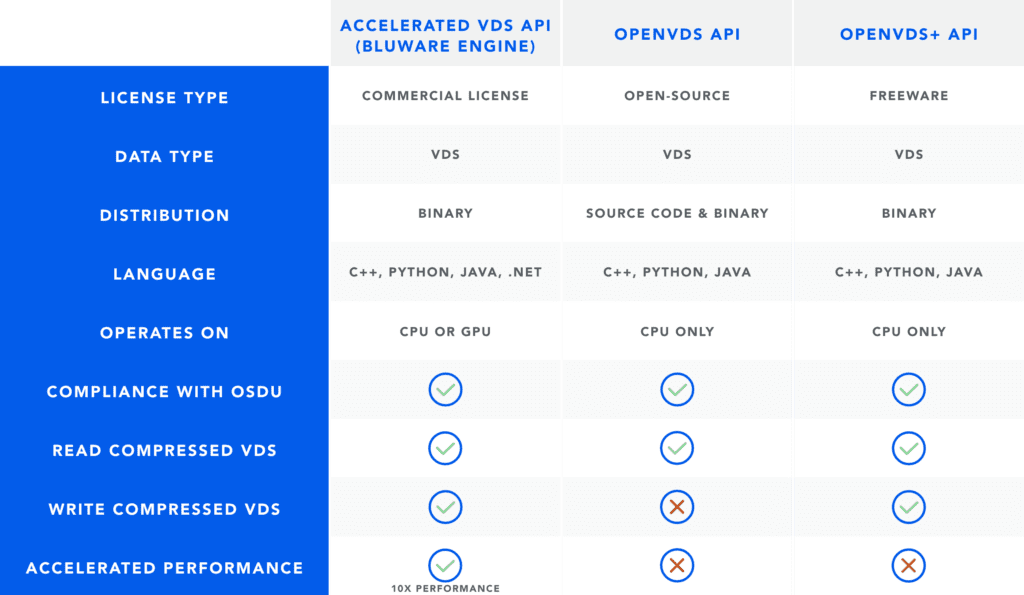What is OpenVDS+?
OpenVDS+ is a binary library. It can read and write to Bluware Volume Data Store (VDS™).
How is OpenVDS+ different from OpenVDS?
VDS is a system for storing signal data. It is widely used for storing seismic data in the cloud or within files. OpenVDS is an open-source implementation of VDS. By using the OpenVDS library, it is possible to read and write VDS. Bluware has an industry-leading compression technology for signal data. The OpenVDS+ library provides the ability to write compressed data in VDS format. Note that OpenVDS can read data that has been compressed with Bluware compression or uncompressed (raw) data.
More information can be found here: Understanding the capabilities of VDS and OpenVDS
Can I use OpenVDS+ to compress any file?
The OpenVDS+ library extends OpenVDS by adding compression capabilities. OpenVDS writes to VDS, so therefore the compression is used only for writing VDS.
How does OpenVDS+ compare to Bluware’s commercial access engine?
OpenVDS and OpenVDS+ provide basic read capabilities, including random-access reading. The Bluware commercial data access engine is highly optimized for performance using GPU technology and multi-threading to make reading data up to 10-times faster with the commercial engine.
Is OpenVDS+ Free?
Yes, OpenVDS+ will be free to download and use without restrictions in Q1 2021.
Can I use OpenVDS and OpenVDS+ interchangeably?
OpenVDS and OpenVDS+ are both libraries for reading or writing VDS, with the only difference being that OpenVDS+ can also wavelet compress the data on write. The two libraries are otherwise identical, and therefore can be used interchangeably.
Is OpenVDS+ available through OSDU only?
Both OpenVDS and OpenVDS+ are available outside of OSDU. Bluware will host the binary download for OpenVDS+.
Can I use OpenVDS+ to compress SEG-Y files? What file types does OpenVDS+ work with?
OpenVDS+ is not a compression library. It is a library to compress signal-based data in VDS format. A SEG-Y file could be imported and stored as a compressed VDS using the OpenVDS+ library.
Why isn’t OpenVDS+ Made Open-Source by Bluware?
Bluware’s compression technology is more than 15 years in the making. We have no plans to open-source the compression. However, by creating OpenVDS+, the industry benefits from having free access to the very best compression technology in conjunction with the very best format for storing signal-based data sets such as seismic data.
Why did Bluware create OpenVDS+?
We saw a potential problem emerging for the oil and gas industry where OpenVDS could be used in conjunction with any compression technology such as ZFP. While ZFP is open-source, it is lossy, and the results, when used with seismic data, are sub-standard. If multiple implementations of OpenVDS with different compression technologies become prevalent, this creates a disastrous situation for the industry as data becomes unreadable when it is uncompressed unless you have the technology to decompress it. By providing Bluware’s compression technology for anyone to use for free, the need to use other compression technologies in conjunction with OpenVDS is eliminated. This aligns with Bluware’s desire to provide the very best technology for the good of the industry.
What are the capabilities of VDS, OpenVDS, and OpenVDS+?


When you say “OpenVDS+ will be free to download and use without restrictions”… please could you be more specific about the planned license terms?